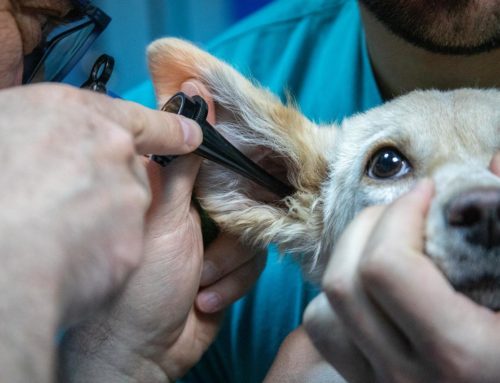
How to Get Rid of Fleas
As warmer months approach, you might have exciting things planned — from day trips to the lake or beach. A spring or summer vacation might also be on the horizon for you and your family. One thing not on the itinerary? Getting rid of fleas.
Unfortunately, fleas thrive in hot, humid weather. They can also be a real pest.
Not to fret. There are things you can do to spot a flea problem, treat it and prevent reoccurrence.
Follow this step-by-step guide to get rid of fleas.
Understanding How Dogs Get Fleas
Fleas can survive up to two weeks outdoors, without a host. Dogs can pick them up from playing in your backyard, at a park or staying at a kennel while you’re away on vacation. Dogs can even pick up fleas from other dogs.
There are four stages of a flea’s life: Egg, larva, pupa and adult. Eggs hatch into larvae and move onto a host.
During the pupa stage, they form cocoons and can make a home in your carpet, sofa or bed until they can find a warm-bodied host, like your dog.
Adult fleas live on animals, digest blood and lay eggs. One female flea might lay as many as 2,000 eggs.
How can you tell if you have a flea problem?
There are a few telltale signs.
Signs Your Dog Has Fleas
Smaller than a grain of rice, adult fleas are hard to see. They also move pretty fast. As such, you’ll have an easier time spotting flea dirt than you will fleas. What is flea dirt? (You might be sorry you asked.) Flea dirt is a combination of blood meal and flea feces. To tell the difference between flea dirt and actual dirt, run it under water. If it turns red, it’s flea dirt.
Although it’s gross, I know, on the bright side, flea dirt can help you easily identify the problem so you can start treating it.
You can also look out for signs of flea bites on your dog. They present as tiny dots that are red and raised.
Three physical signs your dog might have fleas:
- Intense scratching
- Biting and chewing at skin
- Red, irritated skin
Many dogs are actually allergic to flea bites, too. If that’s the case for your dog, you might notice red, flaky skin, hot spots and hair loss. Fleas can also lead to tapeworm.
How to Get Rid of Fleas
Now, the good news. (You’ve been waiting for some good news, right?) It is possible to get rid of fleas. To set expectations, it can take up to three to four months to completely eliminate them. But we’ll help you get there — and provide tips to prevent future outbreaks.
Follow these five steps to help get rid of fleas:
Step 1: Call your veterinarian!
Our favorite products are Revolution Plus for cats (topical) and Simparica Trio for dogs (an oral tablet). Both products will kill fleas very quickly and last for one month. Dogs more than 8 months of age will need to have a heartworm test first. Both of these products require a prescription. If you don’t have a veterinarian or are not able to get in, some over the counter products you may try are Frontline Plus or Advantage (both are topical).
Prior to getting to the vet, you will likely feel as if you need to do something! Remember not to panic! Fleas are more of a nuisance than anything. You can buy a flea comb at any pet supply store, fill a bowl with soapy, hot water. Be certain that the water temperature is tolerable for your own skin by testing it on your wrist.
Step 2: Get your flea comb ready.
Fleas love to hide in your pet’s neck and at the base of their tail. Gather your supplies (flea comb, pet-grooming gloves, and soapy water bowl), split the hair on your dog’s neck with your gloved hands and begin running the comb through it. Between brushes, inspect the comb to see if you spot any fleas, which may look reddish brown. Dip it in the water after inspection and repeat this step until the comb comes out clean (no reddish brown dots).
Step 3: Give your pet a bath.
Since hot, soapy water kills fleas, regular baths are one of the best ways to help get rid of them. Use a pet-friendly shampoo, pre-approved by your vet. Some pets are allergic to flea-specific shampoos and ingredients aren’t always regulated. Partner with your vet to find one that’s safe for your pet and will get the job done. I love Epi-Soothe, which is available without a prescription, and Douxo Calm.
Step 4: Clean the house.
Fleas can easily spread throughout the house when your dog shakes, scratches or lies down. To help get rid of fleas in other areas of your house, wash your bed sheets, pillow covers and blankets in hot, soapy water.
Before putting bed sheets back on, sprinkle Borax on carpets and let it sit for 30 minutes then vacuum. Immediately seal and throw the vacuum bag away in an outside garbage bin.
After washing your own sheets, wash pet furniture and soft toys. However, if you already know you have a flea infestation, you might be better off just throwing inexpensive pet bedding and soft toys away. Again, seal the bag right away and bring it to the outside garbage.
Step 5: Hire a professional to treat the inside and outside of your home.
If steps 1-4 don’t do the job, you may need to enlist the help of a professional exterminator. They’ll do an internal and external home inspection to find the source of the problem and treat it. This might include an environmentally-friendly flea spray or flea treatment for your yard, for example. Make sure to schedule a follow-up inspection to protect against future issues.
Prevent Future Fleas
As the saying goes, “An ounce of prevention is worth a pound of cure.” If your dog isn’t already on a flea control program, ask your veterinarian to recommend one. My favorites (Simparica Trio and Revolution Plus) are two of many options. Bravecto is only given once every 3 months, which some people love. Your veterinarian can recommend the one that’s right for your dog or cat.




